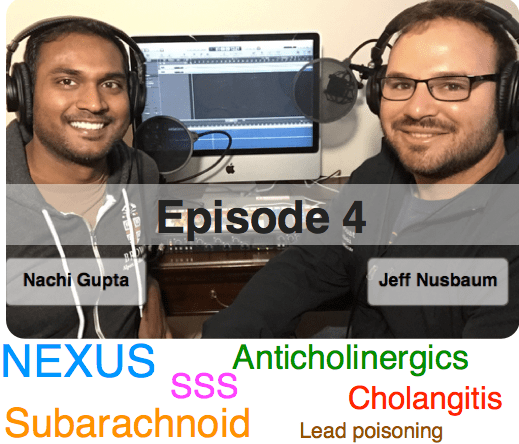Podcast Ep 4: Mnemonics, SSS, Subarachnoid Hemorrhage, & More

“Live as if you were to die tomorrow. Learn as if you were to live forever.” –Mahatma Gandhi
Welcome back! Despite using randomly generating questions, a lot of the question in this episode involved mnemonics. We also review many core concepts in emergency medicine. Enjoy.
You can find our previous episodes here in case you missed them.
Please, please, please send us feedback.
Let’s get started
Question 1
A 55-year-old woman with a history of gallstones presents to the ED with right upper quadrant abdominal pain. Her blood pressure is 98/64 mmHg, heart rate is 110 beats per minute, respiratory rate is 22 breaths per minute, and temperature is 39.8°C. She has scleral icterus and appears jaundiced. She is also mildly confused. She is tender in the RUQ with guarding. What is the most likely diagnosis?
A. Acute cholangitis
B. Acute cholecystitis
C. Acute pancreatitis
D. Spontaneous bacterial peritonitis
Question 2
Which of the following is true regarding cervical spine injuries due to trauma?
A. A focused neurological exam with active range of motion of the cervical spine is essential to clearing the cervical spine
B. A technically adequate 3-view cervical spine x-ray will pick up all cervical spine fractures
C. Odontoid fractures in the elderly are easily identified on plain films
D. The NEXUS and Canadian cervical spine decision rules have very high specificity
Question 3
A 5-year-old girl presents to the ED with a rash that started on her face and spread to her neck, axillae, and groin. Mom states that the patient had an upper respiratory infection one week prior. On examination, the patient’s rash is tender to the touch. Which of the following statements regarding the diagnosis of this patient’s condition is correct?
A. Deep layers of the dermis are involved
B. It often leaves the patient disfigured from scarring
C. Mucous membrane involvement is common
D. The disease is caused by an exotoxin-producing bacterium
Question 4:
A 21-year-old man presents with a headache. What feature should raise the concern for a subarachnoid hemorrhage?
A. Age <40
B. Fever
C. History of intravenous drug use
D. Sudden onset of headache
Question 5
A 20-year-old woman with a history of depression and previous overdose presents with altered mental status. The patient is disoriented with mumbling speech. Her vitals are: T 101.2°F, HR 122, BP 130/82; RR 16. Physical examination is notable for dilated pupils, dry mucous membranes and flushed skin. On ECG, her QRS interval is 60 ms. Which ingested medication is most likely?
A. Diphenhydramine
B. Phenylephrine
C. Salicylate
D. Sertraline
Question 6
A 3-year-old girl with a past medical history of constipation is brought to the ED for evaluation of a limp and left knee pain. Her physical exam is unremarkable. You obtain the knee radiograph seen above. What do you expect to see on her peripheral blood smear?
A. Basophilic stippling
B. Heinz bodies
C. Hypersegmented neutrophils
D. Schistocytes

- Acute cholangitis is defined by Reynolds’ pentad of fever, right upper quadrant tenderness, jaundice, altered mental status, and hypotension
- The NEXUS and Canadian C-spine rules are tools to rule patients out from the need for imaging in trauma. They both have nearly 100% sensitivity, but very poor specificities and therefore cannot rule in injury
- NEXUS can be remembered by the mnemonic NSAID: neurologic deficit, spinal tenderness, altered mental status, intoxication, and distracting injury
- Staph scalded skin syndrome is caused by an exotoxin. It is essentially a severe form of bullous impetigo. These patients have a positive Nikolsky’s sign. Rupturing the bullae will not spread the toxin. It is spread hematogenously.
- Subarachnoid hemorrhages cause a sudden onset thunderclap headache. 80% are due to aneurysms. Polycystic kidney disease is associated with an increased incidence of subarachnoid hemorrhage. Approximately 10% of strokes are caused by SAH.
- Anticholinergic toxicity can be remembered by the mnemonic: mad as a hatter, blind as a bat, red as a beat, hot as a hare, and dry as a bone. They can be treated with physostigmine. Anticholinergic toxicity can be easily confused for sympathomimetic toxicities. However, sympathomimetic overdoses are typically associated with diaphoresis, not dryness.
- A knee X-ray with hyperdense lines at the metaphysis is a classic finding in lead poisoning. Lead poisoning is treated with either succimer or IV EDTA in acute overdoses.
Please provide us feedback at feedback@roshreview.com Hopefully you enjoyed listening to this week’s episode and learned a thing or two as well. Don’t forget to subscribe to Roshcast on your favorite media player (iTunes, downcast, etc.) to ensure you will be the first to know about new episodes as they go up.
Until next time,
Jeff and Nachi
P.S. Please visit Rosh Review if you are looking for more high-quality emergency medicine board review.





Comments (0)